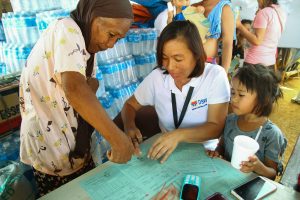
Makilala, North Cotabato (MindaNews) –Among the 19 evacuation centers in this quake-stricken town, this evacuation camp in Barangay Concepcion stands out for hosting mostly Moro and Lumad (Indigenous Peoples) families from Barangay Buhay, a village at the foot of Mt. Apo that has been declared a “no-build zone.”
The Moro and Lumad communities in North Cotabato are a minority in a province whose population as of August 2015, according to the Philippine Statistics Authority was 1.38 million. In this camp, however, they constitute the majority.
As of Friday, November 8, the Department of Social Welfare and Development (DSWD) was still validating the exact number of families in the camp but Jamal Ali, the camp manager on duty then, told MindaNews their initial listing was 381.
MindaNews learned from the Moro and Lumad representatives in the camp that there are 299 Moro and Lumad families – 164 Moro and 135 Lumads. The rest are settlers from Samar and Leyte.
Akisa Palawan, representing the Moro families, said there are 164 in the camp while 25 others are staying with relatives in other areas.
Myrna Linao, IP Mandatory Representative in Buhay listed 135 families in the camp, while two others are staying with relatives.
“They know each other. They belong to the same community, Barangay Buhay,” Lina Canedo, Municipal Social Welfare and Development Officer explained.
Ali, who is based in Koronadal City, said he volunteered to be assigned to the predominantly Moro camp and was allowed to, because he speaks the language of the predominantly Moro group and understands their culture and their needs. Ali is a Meranaw, like the predominantly Meranaw bakwits from Buhay. And his family and other relatives in Marawi, he said, were also internally displaced persons (IDPs) during the Marawi Siege in 2017.
Ali has made sure that toilets would be constructed in the camp, starting with four “genderized toilets” – two each (male and female) for the Moro and Lumad communities, and two community kitchens, one each for the Moro and Lumad as the latter may cook pork which is ‘haram’ (forbidden) to the Muslims.
He has also made sure that a makeshift prayer room be constructed and was quite worried that it was Friday, a time for the Muslims’ congregational prayers at noon.
Ali acknowledged that some food packs for the evacuees that contain canned goods and noodles, ended up in the hands of Moro families. He said this is the reason why donors must coordinate with the local government so they know that in this area, there are Moro families.
Ali has instituted corrective measures by trading the pork items that had been given to the Moro, with non-pork items and for the supply that are still in the stockroom, segregation of the pork and non-pork items before distribution. If donors had coordinated, there would have been no problem, he said.
The evacuees themselves have adopted their own corrective efforts, though.
Because the Moro and Lumad families come from the same village and know each other (the barangay captain is a Meranaw, according to Ali), canned goods or cup noodles with pork content given to the Moro families are either passed on to the Lumads and those of migrant stock, or exchanged for non-pork food items.
Palawan said in the first few days before the DSWD and the local government unit set up tents ini the camp, she had the “haram” goods collected and “ipasa namo sa mga lumad kaysa ilabay namo” we passed them on to the Lumads instead of throwing them).
The sleeveless shirts that also found their way into the relief goods for the Moro, they also passed on to the Lumads, she said.
Buhay and three other villages have been declared “no-build zone” among Makilala’s 38 villages following the series of earthquakes that struck North Cotabato and neighboring areas, four of them above Magnitude 6, between October 16 and 31.
Sheryl Orbita, Makilala Municipal Administrator, told MindaNews that the local government is looking for relocation for residents of the villages declared ‘no build zones’ – barangays Bato, Buhay, Cabilao and Luayon.
She said they have several options to choose from but they will have these checked by the Philippine Institute of Volcanology and Seismology (Phivolcs) and the Mines and Geo-sciences Bureau.
In the areas declared as “no-build zones,” Orbita said Phivolcs informed them farming can still be done at daytime but not when it rains. Living there, however, will not be allowed, she said.
According to the historical narrative posted on the website of North Cotabato, “before the coming of the Christian migrants from Luzon and the Visayas which had accelerated the growth of settlements and subsequently gave rise to bustling municipalities, this area named Cotabato was inhabited by various ethnic groups namely: the Manobos, the Bagobos and the Muslims sometime in 1500 A.D.” (Carolyn O. Arguillas / MindaNews)

